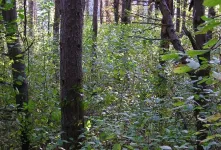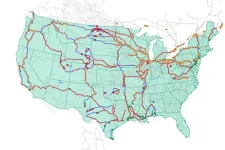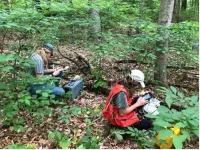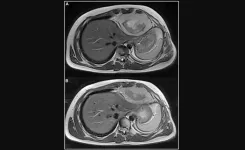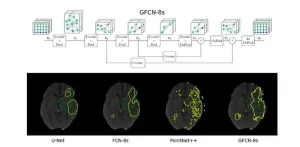(Press-News.org) URBANA, Ill. — Over half of forests in the United States are privately owned, especially in the Eastern part of the country. This can make control of invasive species challenging, as efforts need to be coordinated among many different landowners. A new study from the University of Illinois Urbana-Champaign looks at how family forest landowners in Maine and New Hampshire approach invasive species management and what factors influence their decisions.
“We have mostly public land on the West Coast and privately owned family forestland in the Midwest and the Eastern Seaboard. Private landowners are going to have different preferences, so what will happen when collective action is required to manage invasive species?” asked Shadi Atallah, associate professor in the Department of Agricultural and Consumer Economics, part of the College of Agricultural, Consumer and Environmental Sciences at Illinois.
There are three main categories of private family forest landowners, Atallah stated. There are recreational landowners who primarily want to enjoy the land; owners who are looking to get supplemental income from timber; and others who seek to combine recreational and income opportunities. Each group has different priorities and motivations for managing their forests, and this has implications for policy makers.
Atallah is lead author on the study, which focused on control of glossy buckthorn in eastern white pine forests. This is an exotic and invasive species that can cause substantial problems if not managed.
“Glossy buckthorn can grow as high as a person so it can block recreational activities such as hiking, biking, and wildlife watching. It’s also going to inhibit the ability of the white pine forest to naturally regenerate, because it will shade juvenile trees and limit their growth. Thus, it is both an economic problem and a problem for the provision of ecosystem services,” Atallah said.
The researchers conducted a survey with 939 forest landowners in Maine and New Hampshire to gauge preferences, motivations, and willingness to pay for glossy buckthorn control on their land. Respondents also received an informational brochure about the invader, explaining identification, problems, and control methods.
The survey was designed as a choice experiment, where respondents were presented with a series of different scenarios and asked to make hypothetical choices for management options and outcomes. The options differed in ecosystem service benefits (trail recreation, wildlife, timber), control methods (mechanical or chemical), neighborhood adoption rates, and costs. Each respondent received a random combination of options.
Current conservation cost-share programs in the region reimburse landowners for up to 75% of the cost of controlling invasive species. According to survey results, this is sufficient to encourage mechanical but not chemical control.
“We find that family forest landowners have a very strong preference for mechanical control methods, although they are more expensive and less effective. In fact, owners have a negative willingness to pay for chemical control, which means they actually would have to be paid to use this method,” Atallah stated.
On average, landowners prefer control options that increase timber regeneration and wildlife viewing. Owners of large forest lands are also motivated to control invasive species in order to improve trail recreational activities.
The researchers found that owners of smaller forests are strongly influenced by what their neighbors are doing. Neighborhood effects are significant for those owning less than 26 acres, which is 80% of all landowners in the area.
“We show that it’s going to increase a landowner’s willingness to pay for control if their neighbor is also doing so. If everybody else is controlling, it becomes more cost effective,” Atallah said.
Conservation agencies can capitalize on this finding, he noted.
“Because this problem exists in a region with a lot of privately held land, there is an opportunity to build on that neighborhood effect,” he said. “For example, the Natural Resources Conservation Service (NRCS) or Cooperative Extension could provide information to landowners about the control level in their neighborhood to increase their likelihood of action. Landowners view their control as a complement to their neighbors’ efforts, which can benefit the areawide management of invasive species.”
Forest landowners’ strong preference for mechanical control also has policy implications.
“We have these environmental preferences that could lead to the invasive species spreading because mechanical controls are less effective than chemical methods. An agency concerned with effectiveness at the landscape level might end up subsidizing chemical control more than mechanical,” Atallah stated. “The crux of the problem is how to balance the tradeoffs between landowner preferences, available treatment methods, and the forest health as an ecosystem that would benefit from the removal of non-native, invasive plants.”
Atallah is currently working on a research project to estimate those tradeoffs, which can provide guidelines for conservation agencies seeking to develop management strategies.
Editor’s Notes:
The article, “Family forest landowner preferences for managing invasive species: Control methods, ecosystem services, and neighborhood effects,” is published in the Journal of the Agricultural and Applied Economics Association [doi.org/10.1002/jaa2.60]. Authors include Shadi Atallah, Ju‐Chin Huang, Jessica Leahy, and Karen P. Bennett. Funding was provided by the USDA National Institute of Food and Agriculture grant 1012155.
The College of Agricultural, Consumer and Environmental Sciences (ACES) at the University of Illinois has top-ranked programs, dedicated students, and world-renowned faculty and alumni who are developing solutions to the world’s most critical challenges to provide abundant food and energy, a healthy environment, and successful families and communities.
END
What motivates family forest landowners to manage invasive species?
2023-07-18
ELSE PRESS RELEASES FROM THIS DATE:
Lehigh University Professor Dan M. Frangopol elected into Academy of Engineering of Mexico
2023-07-18
Dan M. Frangopol, the inaugural Fazlur R. Khan Endowed Chair of Structural Engineering and Architecture at Lehigh University, has been elected into the Academy of Engineering of Mexico (AEM) as a Corresponding Member.
According to AEM, the academy was “established to recognize the most accomplished and prominent engineers in Mexico,” and it “selects a number of internationally recognized individuals from around the world with outstanding contributions to engineering following a rigorous nomination and evaluation process.”
An induction ...
UC Berkeley study reveals goal-oriented rewards as key factors in decision-making
2023-07-18
Groundbreaking research from UC Berkeley’s Department of Psychology is shifting the understanding of human decision-making processes by highlighting the importance of goal-oriented rewards. Conducted by Berkeley Psychology Professor Anne Collins and Berkeley Psychology doctoral student Gaia Molinaro, the study suggests that the value people attribute to outcomes is subjective, and heavily influenced by their personal goals and the context of the decision.
"Value isn't just determined by an objective reward or outcome,” Collins said. “Our research suggests that people's perception of value is largely shaped by their personal goals and ...
Virtual rehabilitation program for seniors with frailty shows promise, according to McMaster-led research
2023-07-18
Virtually delivered rehabilitation for seniors living with frailty is a feasible way for delivering care, shows new research led by researchers from McMaster University and the Geras Centre for Aging Research.
The study, published in Pilot and Feasibility Studies on July 17, defined frailty, a consequence of aging, as a decline in function and physiological reserve in multiple bodily systems.
Frailty impacts approximately 1.5 million older adults in Canada, and frail seniors account for a large proportion ...
Safe train transport
2023-07-18
Oak Ridge National Laboratory researchers used images from a photo-sharing website to identify crude oil train routes across the nation to provide data that could help transportation planners better understand regional impacts.
More than 300 crude oil rail incidents have occurred in the U.S. over the past decade, causing adverse consequences from fire and hazardous materials leakage. However, only limited information on the transport routes has been publicly available.
In a study, ORNL researchers used geotagged online photos from Flickr to reconstruct transport paths. By linking geotagged crude oil train images with national railway networks, the team ...
The legacy of past disturbance shapes coastal forest soil stability
2023-07-18
The Science
Coastal forests are increasingly exposed to the effects of climate change and sea level rise. However, scientists have an incomplete understanding of what this means for soil stability. This experiment examined how soil might change when transplanted between parts of a tidal creek that differed in salinity. Scientists found that soils with a history of salinity and inundation by seawater were more resistant to changes in water properties and movement. This suggests that the soils had already “learned” how to adapt to environmental changes. The researchers suggest that differences in the resilience of soils’ carbon ...
Cameron Whitehead wins U.S. Department of Energy’s 2023 CyberForce® Conquer the Hill — Reign Edition Competition
2023-07-18
Unleashing the power of cybersecurity: 2023 CyberForce® Conquer the Hill — Reign Edition competition set the stage for virtual showdown.
In an exciting showdown of talent and skill, Cameron Whitehead of University of Central Florida emerged as the champion of U.S. Department of Energy’s (DOE) 2023 CyberForce® Conquer the Hill — Reign Edition Competition. This virtual event, organized by DOE’s Argonne National Laboratory, involved 144 individual participants from collegiate institutions across ...
Case Report: Intrathoracic synovial sarcoma with BRAF V600E mutation
2023-07-18
“The prognosis of recurrent/metastatic SS remains poor, highlighting the need for a novel therapeutic strategy.”
BUFFALO, NY- July 18, 2023 – A new case report was published in Oncotarget's Volume 14 on July 7, 2023, entitled, “Intrathoracic synovial sarcoma with BRAF V600E mutation.”
Synovial sarcoma (SS) is a highly malignant mesenchymal tumor that occurs mainly in adolescents and young adults. The treatment of SS is multimodal, involving surgery, radiotherapy and chemotherapy. The overall prognosis ...
AAA expands awards program to support students pursuing careers in anatomical sciences
2023-07-18
ROCKVILLE, MD—JULY 13, 2023 – The American Association for Anatomy (AAA) announced the deserving recipients of the AAA Predoctoral Fellowship, the DEI Dissertation Completion Award, and the EUReka EDI Undergraduate Research Award. In 2023, AAA expanded its portfolio of awards, grants, and scholarships by an additional $100,000, now topping out at over $650,000. These opportunities provide much-needed financial support to undergraduate and graduate students, enabling them to conduct groundbreaking research and make valuable contributions to the field.
AAA has continuously demonstrated ...
New geometric deep learning model for detecting stroke lesions
2023-07-18
Ischemic stroke, which occurs when a blood vessel in the brain gets blocked by a clot, is among the leading causes of death worldwide. Fortunately, surgeons now have access to advanced imaging techniques that allow them to visualize the interior of a patient’s brain during a stroke. This helps them pinpoint the location of the clot and analyze the extent of damage to the brain tissue.
Computed tomography-perfusion (CT-P) is one of the most useful imaging modalities in the early stages of an acute stroke. However, it is challenging to accurately identify ...
Luther studying forest fragmentation & climate change
2023-07-18
David Luther, Assistant Professor, Biology, received funding from the National Science Foundation for: "Collaborative Research: LTREB: Forest fragmentation and climate change result in understory warming that adversely affects tropical avian biodiversity at the BDFFP."
Luther and his collaborators posit that remnant bird communities in Amazonian forest fragments are a precursor of future bird assemblages in continuous forest due to understory forest drying from edge effects in fragments and climate change in continuous ...
